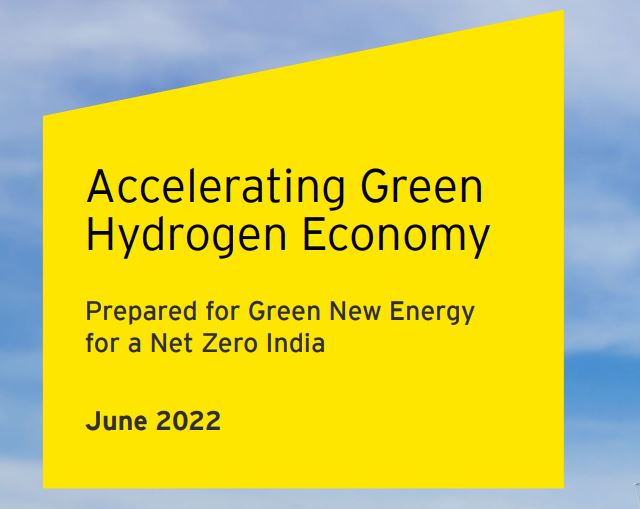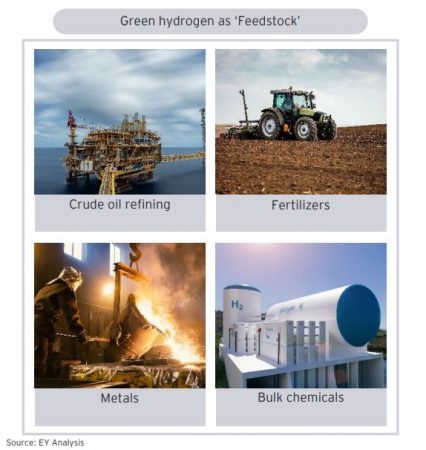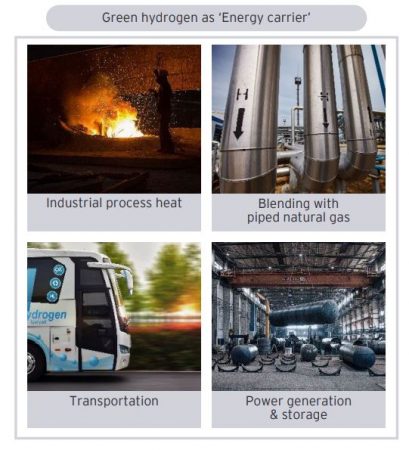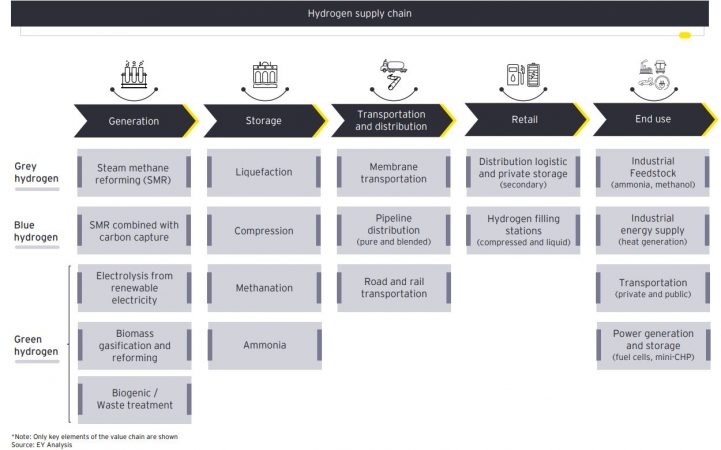115 GW OF Renewable Energy To Power India’s 5 Million Tonnes Green Hydrogen Mission

EY – SED Fund report, “Accelerating Green Hydrogen Economy”, released at the CII’s conference “Green New Energy for a Net Zero India” in Bengaluru made a strong case for the best pathway to execute for India.
The report highlights that India’s ambition to produce 5 million tons of green hydrogen by 2030 will need ~115 GW of renewable power generation capacity and ~50 billion litres of demineralized water supply. To get a sense of this scale, the current all-India installed capacity of renewable power generation is ~113 GW as of May 2022. The country has a target of 500 GW by 2030.
Somesh Kumar, Partner and National Leader, Power & Utilities, EY India, said, “ The emergence of green hydrogen as a promising low carbon feedstock and energy carrier for industrial applications is a boon for India’s long-term energy security, sustainability and self-reliance.”
Further, the report states that the levelized cost of green hydrogen production and storage (LCOH) is currently ~ INR 400/kg. 40-50% of this cost can be attributed to the renewable energy power plant, 30-40% for electrolyzer stack and balance of system including demineralized water supply and 20-30% for compressed storage.


Sivaram Krishnamoorthy, Deputy Director, SED Fund, said, “The race to decarbonise energy intensive industries depends on the competitiveness of green hydrogen supply chain and enabling policy ecosystem to make this happen. State governments have a key role to play in implementing recently notified green hydrogen policy and green energy open access rules 2022 to support the industry in reducing the cost of production”
The EY – SED Fund report recommends key sub-national policy interventions to accelerate the green hydrogen economy:
- Reducing the cost of renewable power generation and supply for GH2 production
- Waiver of intra-state transmission charges for GH2 production
- Waivers, clarity and certainty of open access charges for GH2 production
- Allow banking of surplus energy in the production of GH2
- Fungibility of green hydrogen and renewable purchase obligations
- Improve ease of doing renewable energy open access (REOA) transactions
- Geographic Information System (GIS) mapping and identification of GH2 clusters for development
- Establish state level mission for advancing the GH2 economy, formulate and adopt GH2 production targets separately for industries, transportation and other sectors of the economy
- Single window portal for all statutory clearances, permissions required for manufacture, transportation, storage and distribution of green hydrogen / ammonia
- Production linked incentive schemes (PLI) and fiscal benefits for high efficiency and durable electrolyzer systems
- Enhance public funding support towards R&D programs calling for demonstration of projects that support the competitiveness of the GH2 supply chain and end-use

The report further identifies ~41 shovel-ready projects in the green hydrogen supply chain, out of which 31 are commercial projects and 10 are R&D projects funded by the Department of Science & Technology (GoI). The project’s database comprises green hydrogen production, electrolyzer manufacturing, hydrogen retail and R&D projects. These projects are under permitting or announced stage for the year 2021 till May 2022. In the year 2022, only 7 projects are announced as compared to ~24 commercial projects in the year 2021. The green hydrogen production pipeline project plans to install ~7.77 GW electrolyzer plants, while the cumulative electrolyzer manufacturing project capacity stands as ~4 GW/year.
The EY-SED Fund report also highlights multiple factors that drive the techno-economics of the green hydrogen supply chain:
- Renewable energy (RE) resource availability and economics of round-the-clock power supply: This includes geographical location and proximity of RE resources, CAPEX and OPEX of round-the-clock power supply, interstate & intrastate transmission/wheeling charges, open access, banking and other grid support charges if any. Mechanisms to buy back or sell curtailed power in open markets can help reduce costs. This component typically accounts for 40-50% of the overall LCOH.
- Electrolyzer system efficiency, stack durability and economics: This includes CAPEX and OPEX of electrolyzer stack, water supply & treatment and balance of the system. Energy consumption per unit of hydrogen production (efficiency) at different load factors, stack durability and response to intermittent supply also affect the economics of production operations. This component typically accounts for 30-40% of the overall LCOH.
- Energy efficiency and economics of compression and storage: This includes CAPEX and OPEX for compression system, energy efficiency and consumption, type of pressure vessel, end-use pressure requirement, days of autonomy for sizing pressure vessel, etc. This component typically accounts for up to 20-30% of overall LCOH.
- Demand profile of hydrogen end-use application: This includes the pressure requirement for hydrogen end-use application, hourly and seasonal variations in demand profile and inherent flexibility of end-use application to minimize curtailment.
- Geospatial characteristics of renewable power generation, green hydrogen production, and end-use: This determines the need for additional storage and transportation / distribution infrastructure if any adding to the overall costs.
Note: All visuals and pictures courtesy EY-SED Fund Report




